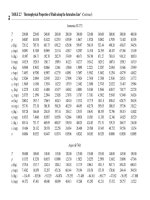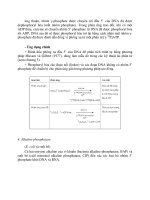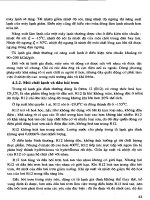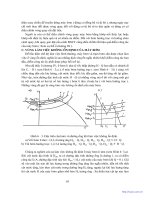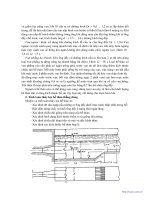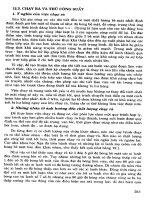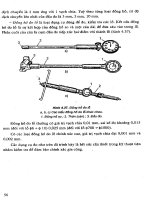Volume 12 - Fractography Part 9 ppsx
Bạn đang xem bản rút gọn của tài liệu. Xem và tải ngay bản đầy đủ của tài liệu tại đây (7.58 MB, 60 trang )
Figure 211 is a polished and etched cross section of a partially flame-hardened crane gear of AISI 1045
steel in which fatigue cracks formed at the roots of many teeth after one year of service. The cracks
have been sharply delineated by etching. Note that hardening did not extend even to the root fillet of
any tooth. Figure 212 is a polished and etched cross section of a portion of a gear that was subjected to
full-contour flame hardening; note the better tooth form, with fully radiused tooth roots. Both etched
Fractographs of case structure on shaft side of axle failure in Fig. 220 and 221. Fig. 222: Structure at
fracture origin. SEM, 20×. Fig. 223 (Same as Fig. 222, but at higher magnification. Note primarily
intergranular fracture. SEM, 1000×. Fig. 224: Same as Fig. 223, but at higher magnification. SEM,
Fractographs of core structure on shaft side of axle failure in Fig. 220 and 221. Fig. 225: Case-core
transition zone. SEM, 50×. Fig. 226 (Core structure at transition zone (see Fig. 225) showing primarily
cleavage fracture. SEM, 1000×. Fig. 227: Same as Fig. 226, but at higher magnification. SEM, 2000×
(General Motors Research Laboratories)
Classic bending overload fracture of automotive axle shaft (direct-on bearing design). Material and
heat treatment: modified AISI 1050, induction hardened and tempered to 60 HRC at the bearing
diameter. The part was broken in the laboratory. Fig. 228: Fracture surface with chevrons in case-
hardened zone pointing to single origin at top. Fine- and coarse-grained structures in case and core
regions, respectively, indicate that heat treatment was properly performed. Fig. 229: Side view of
fractured axle shaft in Fig. 228. (Z. Flanders, Packer Engineering Associates, Inc.)
In-service rotary bending fatigue fracture of automotive axle shaft (direct-on bearing design) due to
improper heat treatment. The modified AISI 1050 part was induction hardened and tempered to 60
HRC min at the bearing diameter. However, the hardened zone did not extend into the flange fillet
radius. Fig. 230: Fracture surface. Note ratchet marks at several locations around circumference
indicating multiple fatigue origins. Fig. 231: Side view of axle shaft in Fig. 230. (Z. Flanders, Packer
Fatigue failure of crane wheel by spalling of a section of its selectively hardened tread. Failure of the
quenched and tempered medium-carbon steel forging occurred after 2 years of operation on a crane
serving an open-hearth furnace. Fig. 239: Spalled section of tread. Fatigue crack originated at a
forging defect (arrow). 3×. Fig. 240: Close-up of failure origin. 0.75×. Fig. 241: Oblique lighting reveals
texture of fracture surface (compare with Fig. 240). Note beach marks associated with fatigue crack
Fatigue fracture of 90-mm (3.6-in.) diam medium-carbon steel axle housing (217 to 229 HB). The part
was subjected to unidirectional bending stresses normal for the application. Fig. 243: Fracture surface
showing four major fatigue crack origins (arrows). Cracks progressed up both sides of the tube and
joined at the small final rupture area at top. Note increasing coarseness of fracture surface as cracks
grew. Fig. 244: Higher-magnification view of origin area in Fig. 243. Note beach marks. A small
Torsional overload fracture of AISI 1060 drive shaft for power boiler stoker grate. Service
temperature: 370 °C (700 °F). Boiler had a history of fractured shafts. This particular grate had
jammed twice before, and each time a new key had to be machined due to twisting of the shaft.
Mechanical properties at surface of shaft: yield strength, 348 MPa (50.5 ksi); tensile strength, 556 MPa
(80.6 ksi); elongation, 31%. Core properties: yield, 300 MPa (43.5 ksi); tensile, 620 MPa (89.9 ksi);
elongation, 25%. Fig. 249 and 250: One half of broken shaft and its fracture surface. Fig. 251 and 252:
Mating half of shaft (two of three keyways are visible) and its fracture surface (note twisting and
smearing). All at ~0.5× (Z. Flanders, Packer Engineering Associates, Inc.)
